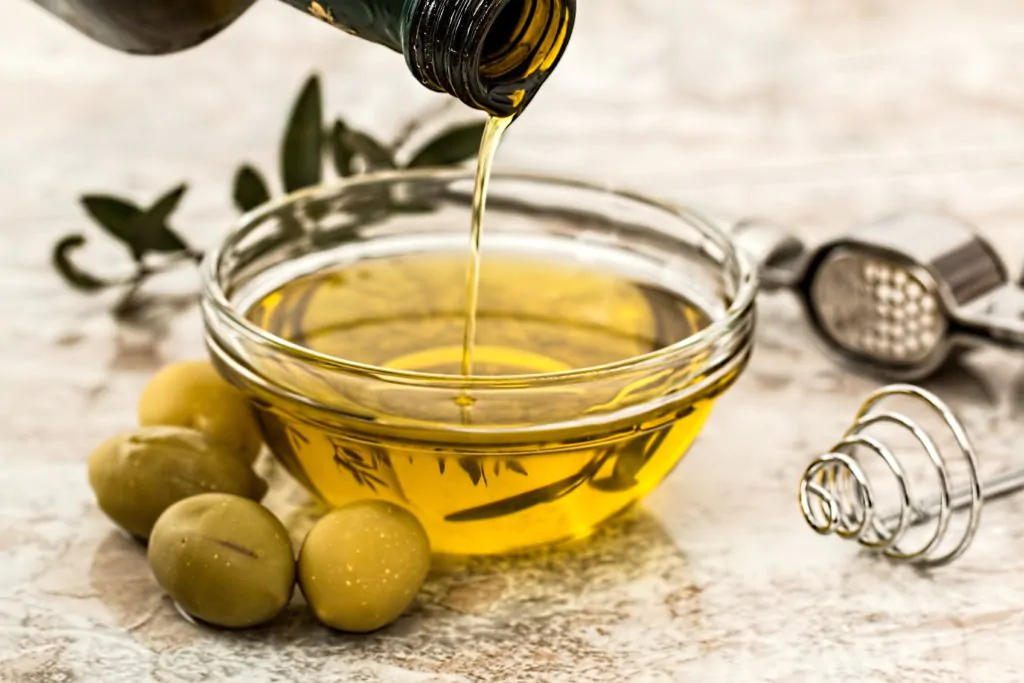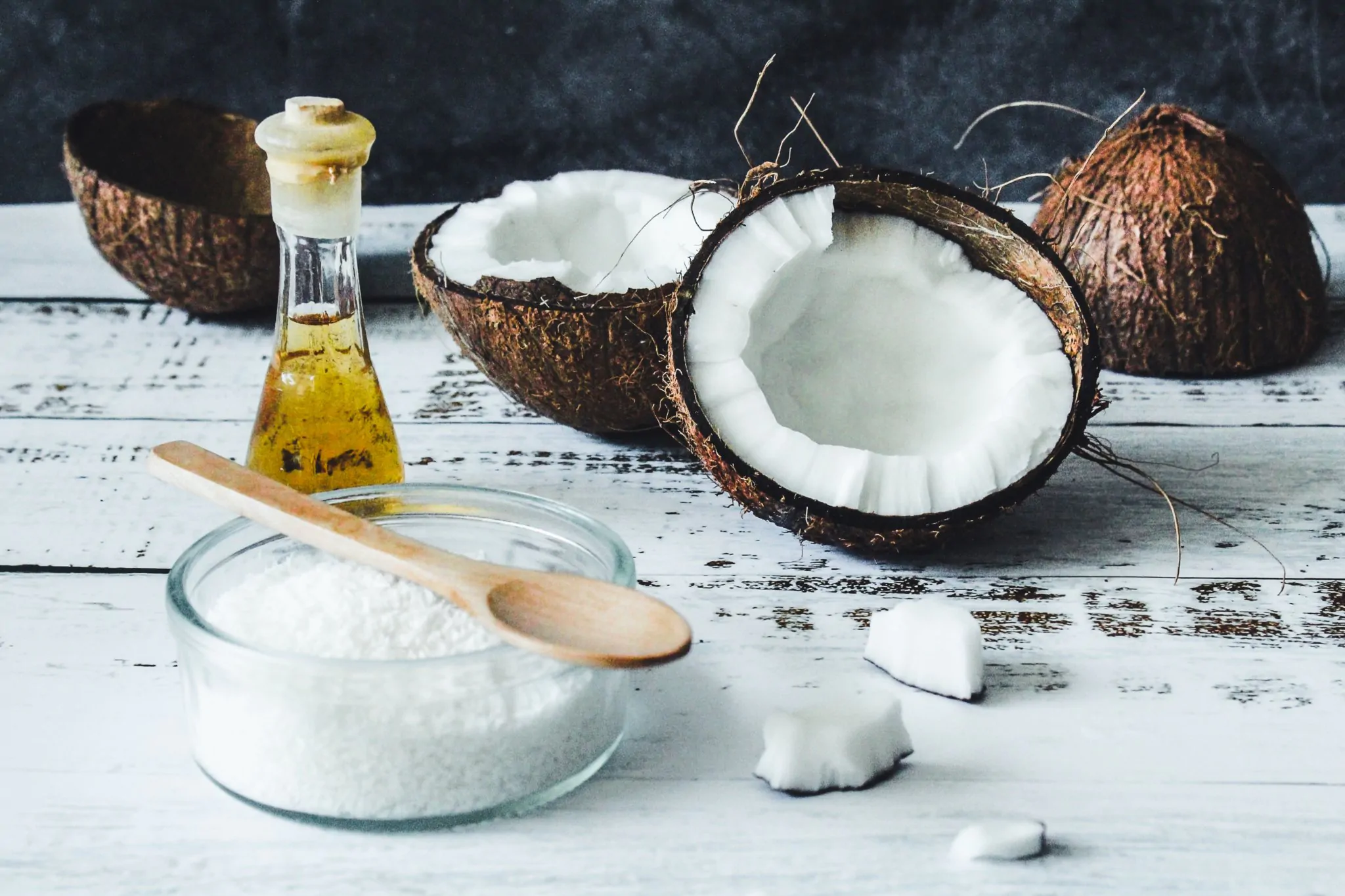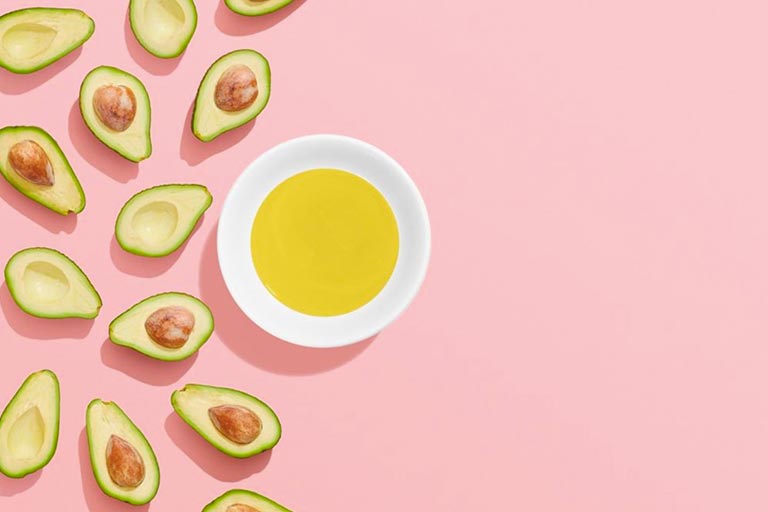Olive Oil, Coconut Oil or Avocado Oil: Which Is Best?
Step into the cooking oil section of any supermarket and you are bound to be confused. There are hundreds of different options, so how do you know which oil is the healthiest for you and your family? It’s enough to make anyone feel overwhelmed, between palm oil, flaxseed oil, sunflower oil, soybean oil, walnut oil, corn oil, grapeseed oil, sesame oil, safflower oil, rice bran oil and more!
Today, we’re going to break down three of the most popular oils discussed in the healthy cooking atmosphere—olive oil, avocado oil, and coconut oil. We’re trying to help you find the best choice of a neutral oil to cook with, so we won’t be discussing more specialized oils such as sesame oil, flaxseed oil or grapeseed oil. Sesame oil has a strong, unique flavor profile, which doesn’t make it a good choice for everyday cooking.
RECORD SCRATCH
Wait.
Is Oil Actually “Healthy”?
We get that a lot, and the answer is, it depends!
First of all, we want to emphasize some very important information: as the USDA will tell you, dietary fats are a key macronutrient and important factor in a healthy diet, with plenty of nutritional value. Unlike oil and water, oil and humans do mix! While fats get a bad rap, and many people still link them to weight gain (although sugar has become a greater suspect in recent decades), fats are not something to be feared – they’re necessary for your body to function, just like carbs and protein! When eaten in moderation, they have positive effects, such as promoting the absorption of fat-soluble vitamins and even contributing to weight loss. One of those fat-soluble vitamins is carotenoids, a key player in eye health, so the absorption of carotenoids and other fat-soluble vitamins and minerals is a big reason why fats matter!
Of course, some fats are better choices than others, and oil is a great alternative compared to fat from dairy products, like butter. That’s why it’s important to choose fats purposefully, and to know the terminology around, and the difference between, different types and varieties of healthy and unhealthy fats.
The three primary types of fats that you’ll find on a nutrition label are saturated, unsaturated, and trans fats. Trans fats are bad fats, and always a no-no. They don’t occur in nature and they’re harmful for your body – more on that below.
Saturated and unsaturated fats are where it gets complicated. Saturated fat comes from animal targets (think lard, butter, milkfat and ghee, a popular ingredient in curries) and is considered to be the less healthy of the two, as it can clog arteries and raise cholesterol levels. The Mayo Clinic recommends that no more than 10 percent of your daily calories come from saturated fat, as high levels of cholesterol are linked to an increased risk of heart attacks and cardiovascular disease. Consuming a lot of saturated fat can even increase your risk for Alzheimer’s disease, which is why it’s a good call to keep an eye on your intake.
Unsaturated fats, also known as unsaturated fatty acids, are considered to be the healthier kind of fat. The opposite of saturated fats, they can actually help lower blood pressure, and they’re primarily found in nuts and seeds. Omega-3 (also known as alpha-linolenic acid, or ALA) and Omega-6 fatty acids, which you’ve probably heard a lot about in terms of a healthy diet, are polyunsaturated fatty acids – a type of unsaturated fat. You may have also heard about monounsaturated omega-9 fatty acids, but these are less written about, as the body can produce them on its own. Omega-3s (alpha-linolenic acid) and omega-6s are known as essential fatty acids, because your body can’t produce them on its own. You may know people who take omega-3 supplements, but the best place to get all your healthy fats is in whole foods like higher-quality oils.
If you’re ever feeling stuck or confused, and want to make sure you’re consuming the right fats, the main difference to remember is that saturated fats come from animal targets and are typically solid at room temperature; whereas unsaturated fats come from plant targets and are typically liquid at room temperature. And as you know, most oils are liquid at room temperature, making them a great, healthy target of fat.
However, different types of oils have different health profiles, and some, like coconut oil, have higher amounts of saturated fat. Not all cooking oils are created equal, and the operative word there is “created”. Quick science lesson: when cooking oil is extracted from its target using heat, which many manufacturers of commercially produced cooking oils do, it becomes rancid and discolored, requiring it to be bleached and deodorized with chemicals that cause oxidative stress in the body. (We’re looking at you, canola oil.) As oxidative stress can damage cells in your body, even leading to cancer in some cases, that means that the companies and brands who produce those gleaming bottles of vegetable oil lining market shelves aren’t telling the whole story about their negative effects. Many vegetable oils also contain other additives and phytosterols — a plant-based cholesterol that’s found in margarine and other refined foods, which experts recommend avoiding.
We know that sounds like a lot to keep track of, but if you’re full of questions, fear not! We’re about to make healthy choices easy with just a handful of tips.
First, when shopping for cooking oil, look for the phrases, “cold pressed” “expeller pressed” or “unrefined oil.” Processes and methods such as cold-pressing or expeller pressing tell you that the oil was never damaged by heat in the refinement process, necessitating chemical correction.
Second, know the oil’s smoke point to avoid adulterating your healthy oils by cooking at high temperatures or higher temperatures than recommended. We’d hate to have you ruin the lovely oils recommended in tip one by rendering them unhealthy with high-heat cooking. Flavor isn’t the only concern; oils heated above their smoke point release toxic compounds. Avoiding that toxic compound release is why knowing an oil’s smoke point is one of the most important things you can do for your health, and for preserving the quality of the product! And since oil can go from hot to too hot in just a minute, it’s important to pay attention to it and prevent any toxic release.
Here’s a handy list of smoke point pointers from the world-renowned Cleveland Clinic. An oil’s smoke point can help tell you the right oil for certain types of cooking, as higher smoke points are better for higher heat cooking. For example, an oil with a higher smoking point is a good choice for stir frying, as stir fry usually needs to be cooked over high heat. But if you’re just roasting kale chips, you can choose an oil with a lower smoke point. And speaking of numbers, don’t forget to check the oil’s expiration date; even shelf-stable oils have one!
Third, avoid oils that are hydrogenated or contain trans fats. These versions of oil are considered to be “bad” fats: they contain free radicals and also cause the inflammation and oxidative stress mentioned above, which can contribute to things like high blood pressure and stroke. Trans fats also occur when deep frying food, so as delicious as they are, take action to try and avoid deep fried foods like french fries or cheese curds. No bueno.
Finally, no matter which healthy cooking oil you choose, use it wisely and with moderation. You’ve probably heard that good fat in your diet is important, and it is, especially when its nutrients remain intact. Yes, we said, nutrients! Depending on the oil, it can be a good target of vitamins E, K, and many other essential vitamins. Some cooking oils even have antibacterial properties or cholesterol-optimizing benefits, BUT don’t go overboard. While the healthiest cooking oils have an important place in anyone’s diet, they’re still one of the most calorically dense foods out there. One tablespoon of avocado oil or one tablespoon of coconut oil, like most oils, clocks in at around 120 calories, which means that using it too generously can hurt your weight loss goals. Consider cooking oil as an ingredient for food prep or a flavor enhancer, then focus on getting many of your healthy fats, especially polyunsaturated fat, from whole food targets like nuts, seeds, or fish, as practitioners of the Mediterranean diet have for centuries with incredible results.
Alright, people, onto our faves!
Olive Oil

Most people consider olive oil to be one of the healthiest oils out there, and they’re not wrong. Chances are, at least half of the cooking oil aisle in your local supermarket is made up of olive oils, and there’s a good reason why. Many cultures have understood the health benefits of olive oil for thousands of years, but in modern culture, it became the gold standard and pantry staple of the cooking world after a series of studies were published in the late-1990s and early-2000s showcasing the countries where it was a dietary staple and how the general populations of those countries, most following a Mediterranean diet, shared impressively good health. Edging out the reigning champ, canola oil, which is a good thing, because most canola oil is anything but healthy.
You’re probably most familiar with olive oil in the form of extra-virgin olive oil, as it’s what most recipes call for. It’s also the best for you, as extra-virgin olive oil is guaranteed to be cold-pressed, and to have a neutral taste that’s great for cooking.
- What Does It Taste Like? The darker the color of the olive oil, the less processing it undergoes, and the more pronounced the olive oil tastes. It doesn’t usually taste like the olives in a martini, but high-quality olive oil can have a slightly brine-y aroma. Lighter, extra-virgin olive oils are usually almost entirely neutral in flavor.
- What’s Good About It: Olive oil has long been lauded as a healthier cooking oil because of its antioxidant profile (which studies show has the ability to benefit MS). Being made from olives, it also contains trace amounts of minerals. Olive oil also is a good target of monounsaturated fatty acids, and it’s high in polyphenols, an important plant-based micronutrient. And if you suffer from diabetes, the oleic acid in olive oil has been shown to reduce insulin resistance. The American Heart Association has found good evidence that it might even help lower the risk of heart disease and improve heart health. It’s also readily available and very affordable.
- What’s Not So Good About It: The Omega-3 fatty acid to Omega-6 fatty acid profile of olive oil sways to the unhealthy side of things. Olive oil also has a relatively lower temperature smoke point (around 350 degrees F, depending on the grade of oil), so avoid using it in a screaming hot oven or pan to sear food.
- Recommended Use: The light, neutral flavor of higher-quality extra-virgin olive oil is excellent in uncooked applications like tossing vegetables, or in salad dressings. A drizzled teaspoon or tablespoon of olive oil adds great flavor to soup, too!
Avocado Oil

Just a year ago, you’d have to hit up a health food store to find avocado oil, but now, you can grab this relative newcomer at most grocery stores and wholesale club stores in the United States. Avocado oil is a great option for all kinds of cooking and baking because of its light, mild flavor and smell (just like the pulp of avocados that it’s made from).
- What Does It Taste Like? Avocado oil tastes even more neutral than olive oil, which is why it’s one of the best options for just about any cooking or baking need, or even for dips! Remember to keep an eye out for unrefined avocado oil – it’s better for you than refined, but it won’t affect the taste.
- What’s Good About It: Avocado oil has one of the higher smoke points of most types of oils, at 500 degrees F, which makes it the best cooking oils for high-temperature recipes. One of the benefits of avocado oil is that it’s so mild, which makes it a great option almost anywhere in the kitchen—try it in your bread, baked goods (even cakes!), pasta sauces or pizza crusts. Between its neutral flavor and high smoke point, it’s a more perfect candidate than peanut oil for stir-frys, especially if you don’t always want peanut oil’s nutty taste. It’s also great for grilling or pan sauteing protein. Like olive oil, if you are going to replace not-so-healthy fats like trans fats, avocado oil is a good option because it’s rich in monounsaturated fats (healthy fats that only have one double bond).
- What’s Not So Good About It: Just like with olive oil, avocado oil suffers an Omega-3 to Omega-6 imbalance, so you’re better off getting your healthy fats from more whole food targets like salmon. Additionally, compared to other different oils, it can have a high price point.
- Recommended Use: this heart-healthy oil is great anytime you need a cooking oil for things like sautéing meat, protein, veggies or making eggs. It’s also amazing in homemade mayonnaise, because it politely allows the other ingredients to shine.
Coconut Oil

In recent years, you can’t spend 10 seconds on the internet without someone talking about their love of coconut oil. Coconut oil use is all the rage, and both women and men use it in cosmetics as a moisturizer for their face and skin, a hair treatment, and even to clean their teeth (talk to your dentist before you make any major changes to your dental routine). Here, we’re going to focus on the health benefits of coconut oil in terms of cooking with it and using it as an ingredient, rather than the cosmetic experience. Fun fact: most of the world’s coconut oil is produced in Indonesia and the Philippines.
- What Does It Taste Like? Coconut. There’s no getting around it, coconut oil is very, well, coconutty, particularly if it’s unrefined coconut oil. If you love dried coconut meat or coconut flesh, AKA shredded coconut, you’re in for a treat. If you don’t like coconut, you might want to look elsewhere, as this oil even has a strong coconut smell. You may think that you can tweak how much flavor your coconut oil will have by selecting extra virgin coconut oil rather than virgin coconut oil, but in reality, these two coconut oils are the same. The U.S. does not have a legal definition or standard for “extra-virgin” versus virgin coconut oil, so there’s essentially no difference between the two. Unrefined coconut oil, however, will have a stronger flavor mixture.
- What’s Good About It: If you love the taste and smell of coconut products, coconut oil adds wonderful coconut flavor, particularly unrefined coconut oil. But keep in mind that from a health standpoint, the benefits of coconut oil are fraught with conflicting problems and controversy. One article will tell you to eat coconut oil by the spoonful. The next will tell you to never eat coconut oil again. Even expert registered dietitians and dietitian nutritionists (RDs and RDNs) disagree. We need more research and information about the health claims of coconut oil to prove who is correct. Proponents of coconut oil say that it can help reduce your risk of Alzheimer’s Disease, improve heart health by lowering your risk of heart disease (because of its anti-inflammatory properties), and help balance your hormones, which can also improve the condition of your skin, especially if you suffer from acne or other skin conditions like Eczema or Psoriasis. Studies have proven that coconut oil can even help boost your HDL or “good” cholesterol (compared to “bad” cholesterol, LDL). Coconut oil also has a similar medium-high smoke point to olive oil, so it’s not ideal for high-temperature cooking. However, many vegans like it as a substitute for butter in baked goods and meals.
- What’s Not So Good About It: Many healthcare professionals point to the high saturated fat content (about 90%, compared to 63% for butter) as a reason to stay away from coconut oil in large amounts. According to the Mayo Clinic, saturated fat raises cholesterol levels for both “good” HDL cholesterol and “bad” LDL cholesterol, which is a good reason to consume it in small amounts. Lovers of coconut oil say that it is a different kind of saturated fat (known as a medium-chain triglycerides, or MCTs) that is actually beneficial for your body—and that the vast array of other benefits outweigh any negatives. About half of the fatty acids within coconut oil come from lauric acid, which is a medium-chain triglyceride. Despite being a fat, lauric acid gets converted to energy, rather than stored as fat. Compared to other saturated fats, lauric acid, being a medium-chain fatty acid, contributes the least to fat storage, and therefore, the least to weight gain, which is one of the reasons that coconut oil advocates love it so much. So much that they’ll put a teaspoon of it in their coffee instead of milk, which is where the idea of bulletproof coffee comes from. But again, there haven’t been definitive recent studies to prove whether or not coconut oil’s benefits outweigh its high saturated fat content.
- Recommended Use: Coconut oil is solid at room temperature or in the fridge, but easily melts at 76°F. Coconut oil can be used in place of almost any other fat or oil in baking or cooking. But, again, you will taste the coconut, so if you aren’t a big fan (or if it wouldn’t be appropriate for the dish), you may want to choose a less intensely flavored oil. If you’re looking for an idea to add coconutty flavor and fat to a smoothie, you could try a bit of unrefined coconut oil.
Opinions on coconut oil vary; from the people who love it and think it’s a cure for everything to a Harvard professor who famously called it pure poison. The bottom line for coconut oil, like everything else, is to use it in moderation, and keep an eye on new research, nutrition reviews and dietary guidelines from the USDA. It is our favorite out of all the tropical oils, as palm oil and palm kernel oil contribute to deforestation.
We know that the oil selection at the grocery store can be overwhelming, between safflower oil, sunflower oil, soybean oil, walnut oil and more. Ultimately, we think that olive oil and avocado oil are both great, neutral, healthier oil options for a healthy lifestyle, and for all your cooking and baking needs! They also have some of the highest monounsaturated fat content around.
To make a comparison, avocado oil has a higher smoke point than olive oil, and that high smoke point means that it’s more adaptable for different cooking methods, but it is more expensive. And as for coconut oil, we suggest using it in moderation until more research comes out. We hope this helped make your search for healthy cooking oil a little less daunting and your dishes a lot more delicious. And remember, store all your oil jars in a cool, dark place in your pantry (but not your refrigerator, which can mess with the texture), so they can retain their nutritional profile.



